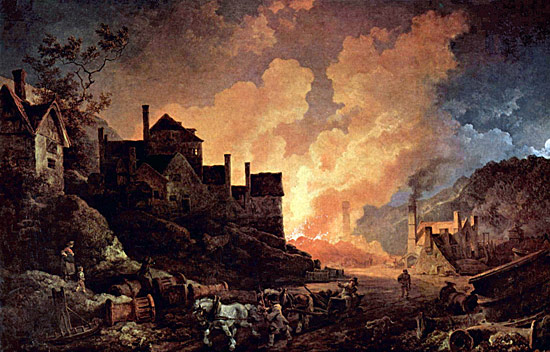
Unit 3: Revolutions and Reaction
Lesson E: The Origins and Spread of the Industrial Revolution
Lesson Overview
The Industrial Revolution began in England in the second half of the 18th century. It was preceded by advancements in agriculture in which farms doubled their production and then, with the help of newer technology, doubled their production again. Coal, iron, and other natural resources were mined from the ground and used in production. The steamboat replaced boats powered by wind and sails. The small homes of cottage industries were gradually replaced by large factories that employed hundreds of people. Banks loaned their money to those willing to invest in even more factories. The landscape of England was changing. In this lesson, you will learn the causes of the Industrial Revolution and why it began in England.

Blast Furnaces Light the Iron-making town of Coalbrookdale in Great Britain [1]
Key Questions
- What social, political, and economic conditions lead to the overthrow of established ideas?
- How do artifacts and documents influence how history is written?
- How do trade and migration patterns cause intellectual and cultural transformations?
Student Outcomes
- Describe the characteristics of the agricultural revolution in Western Europe and its relation to industrialization.
- Analyze the internal and external geographic, economic, technological, and political facts that resulted in industrialization in western European countries and the United States with those of Russia and Japan.
- Analyze relationships between the expanding world market economy of the 16th through the 18th centuries and the development of industrialization, including comparison of the positions of Britain, China, and India.
- Examine how new inventions, including the railroad, steamship, telegraph, mass production, photography, and internal combustion engine, transformed patterns of global communication, trade, and state power.
- Analyze how new forms of generative power contributed to Europe’s "second industrial revolution".
- Analyze cause-and-effect relationships and multiple causation, including the importance of the individual and the influence of ideas. (Historical Thinking Skill)
- Draw comparisons across eras and regions in order to define enduring issues. (Historical Thinking Skill)
Key Terms
Student Resources
- Industry Develops (doc)
- Historical Investigation - The Birth of an Economic Revolution (doc)
- A Second Industrial Revolution Graphic Organizer (doc)
- Relationships Evolve - Brief Constructed Response (BCR) (doc)
Chart of Activities
| Activities to Complete | Estimated Time |
|---|---|
| Pre-Assessment | 10 minutes |
| Key Terms | 5 minutes |
| Activator: The World 1770-1850 | 5 minutes |
| Opening: Revolutions Then and Now | 10 minutes |
| Activity 1: From Mercantilism to Capitalism | 10 minutes |
| Activity 2: The Development of Industry | 15 minutes |
| Activity 3: A New Economic Cycle | 10 minutes |
| Activity 4: Impacts of Innovation | 10 minutes |
| Activity 5: The Birth of an Economic Revolution | 15 minutes |
| Activity 6: A Second Industrial Revolution | 15 minutes |
| Review and Assessment | 10 minutes |
| Lesson Summary | 5 minutes |
Lesson Completion Time
The total estimated time to complete this lesson is 120 minutes.
Page Notes:
[1] Source: This image from http://en.wikipedia.org/wiki/File:Philipp_Jakob_Loutherbourg_d._J._002.jpg is licensed under the GNU Free Documentation License.

